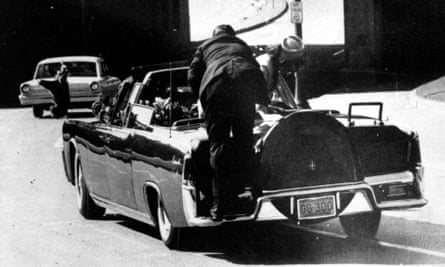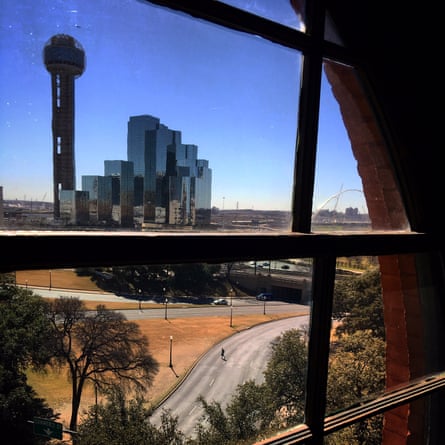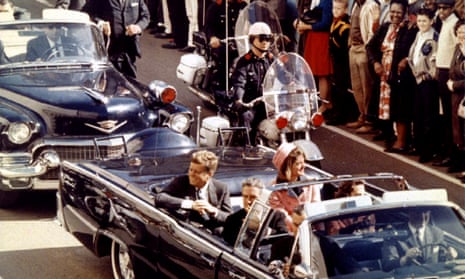The brick walls are painted white. Dozens of cardboard boxes marked “Books” are stacked like a barricade on grimy floorboards. At the south-east corner window, the boxes appear to form a sniper’s perch. It was here 60 years ago on Wednesday that, by official accounts, Lee Harvey Oswald fired three shots heard around the world.
The assassination of John F Kennedy, the 35th US president, shone an unforgiving light on Dallas, Texas, which came to be known as the “city of hate”. Six decades later, the city has grown beyond recognition and come a long way in grappling with that legacy. But the forces that turned Dealey Plaza into a white hot crucible are arguably more prevalent than ever.
A 24-hour news cycle; gun violence; casual accusations of treason; rightwing extremism and Confederate flags; conspiracy theories and distrust of authority – all are part of the story of the Kennedy assassination and, perhaps more than when the 40th or 50th anniversaries were commemorated, all are newly resonant today.
“The political climate now is like the closed-minded climate that was in Dallas at the time of the assassination where people believe what they believe,” said Carolyn Barta, 84, a veteran journalist born and raised in Dallas. “‘If you didn’t believe that, you were wrong and I’m not considering your opinion or how you see things.’ It’s the same sort of condition that is now prevalent in the country and it’s frightening.”
In the 1960 presidential election, Dallas had voted for the Republican Richard Nixon over Democrat Kennedy by the biggest margin of any major city. Kennedy’s civil rights bill, introduced in 1963, was unpopular in the south. In the nine months before his Texas swing, he received more than 400 death threats nationwide.
In Dallas, the buckle on the Bible belt, the hostility was a toxic mix of racism, anti-communism and religious bigotry aimed at America’s first Catholic president – some feared that Kennedy was being controlled by the pope. Extremist groups such as the John Birch Society and the Minutemen were small but vociferous.
Mike Rawlings, a Democrat who was mayor of Dallas from 2011 to 2019, said: “There was definitely a very conservative bent. The John Birchers were the worst of it but still there was a lot of folks that were that way. It was the Tea Party and Maga [Make America great again] before the Tea Party and Maga.”

The rightwing firebrand Edwin Walker, a former army general who in 1962 was charged (but not convicted) with “insurrection and seditious conspiracy”, moved his base of operations to the city. A protest flyer circulating Dallas in 1963 had photos of Kennedy with the headline: “Wanted for treason.”
Bill Minutaglio, a journalist and co-author of Dallas 1963, which examines the extremist elements of the time, also sees modern parallels. “People say you could change the title of that book to ‘United States 2023’ because of a lot of the polarisation and anger and vituperative nature of the political discourse. The social commentary that seemed to be redolent and pervasive back then sure seems to be in existence today.
“There was an extreme amount of anger and hate in the city of Dallas in 1963 but it was marshalled by a small minority of people. They just happened to be people that held what I call the public microphone. They had access to the airwaves, church pulpits, newspapers, political forums and they were angry and they were hateful – there’s just no other word for it. They seemed to have cornered the market in terms of the social climate.”
There had been hints of danger in Dallas. Four days before the 1960 election, Kennedy’s running mate, Lyndon Johnson, was heckled by protesters who spat in the direction of his wife, Lady Bird, and grabbed her gloves and threw them in a gutter. A month before Kennedy’s visit in 1963, the UN ambassador, Adlai Stevenson, was spat on and hit on the head with a placard, prompting some advisers to warn Kennedy to stay away.
And on the day of the president’s arrival, the Dallas Morning News newspaper contained a full-page, black-bordered advertisement that included 12 rhetorical questions that accused Kennedy of being soft on communism and betraying US allies. Kennedy reportedly read the ad and remarked to his wife Jacqueline, “we’re headed into nut country”.
But oligarchs in Dallas, aware of the dangers, had called for a dignified reception for Kennedy and tried to tighten security. About 200,000 people came out to watch the motorcade and give the first couple an effusive welcome, waving signs and flags including the Confederate flag. As they neared Dealey Plaza, Governor John Connally’s wife, Nellie, told Kennedy: “Mr President, you can’t say Dallas doesn’t love you.”
The presidential limousine turned off Main Street at Dealey Plaza at around 12.30pm. As it passed below the Texas School Book Depository, gunfire suddenly erupted from a window on the sixth floor, sending onlookers diving and running. Bullets struck the president’s neck and head and he slumped over toward Jacqueline. Governor Connally was shot in the back but survived.

The car sped off to Parkland Memorial hospital a few minutes away. A Catholic priest was summoned to administer the last rites and, and at 1pm, the 46-year-old Kennedy was pronounced dead, sending shockwaves around the world. In Britain, Big Ben tolled every minute for an hour and lights dimmed in Piccadilly Circus; in Germany, 60,000 West Berliners held an impromptu torchlight parade.
The death of a president gave birth to the 24-hour news cycle as, for the first time, major TV and radio networks cancelled regular programming to provide wall-to-wall coverage of preparations for Kennedy’s funeral and the criminal investigation in Dallas. Hundreds of reporters crammed into the police headquarters, where Oswald held a bizarre press conference and was subsequently shot dead on live television by a nightclub owner, Jack Ruby.
That incident sealed Dallas’s fate. The New York Times newspaper described it as “not too many decades removed from the vigilante tradition of the old frontier” (even today, around the corner from Dealey Plaza, Wild Bill’s Western Store sells parody pistols and bullets with the slogan: “We don’t call 911.”)
Patricia Puckett-Hall, 71, who remembers Oswald helping her with homework when he rented a room from his grandmother, and who now runs the Oswald Rooming House Museum, said: “The country renamed Dallas the ‘city of hate’ and for about 20 years we could not get tourists to come to Dallas. We couldn’t get conventioneers, we couldn’t get new industry to come to the Dallas area.
“We were truly taboo economically and there were thousands of stories where family or businessmen would go north-east and the cab driver, being friendly, would say where you from? If they made the mistake of saying Dallas, the driver would pull over, throw their things on the sidewalk and leave them wherever they were. The word got passed through the grapevine: do not tell them you’re from Dallas.”
Within the city, there were attempts to bury the stigma. Some wanted to demolish the book depository. Mary Kay Ash, a cosmetics entrepreneur, told CBS in 1984: “I think what we should have done is tear that building down, not put up that plaza, not do anything to commemorate it and make a parking lot of out of that thing and not have it there for people to remember.”
But the book depository was saved and, after much soul searching, the Sixth Floor Museum opened there in 1989. The sniper’s perch at the corner window is recreated based on crime scene photos and encased in glass. Other exhibits include an Italian-made Mannlicher-Carcano rifle identical to the one found by investigators, Oswald’s wedding ring, Ruby’s grey fedora hat and a scale model of Dealey Plaza built by the FBI, complete with strings tracing the paths of the bullets.
Neither the Warren Commission nor a congressional select committee found any evidence of a plot from extremist rightwing groups or the Central Intelligence Agency (CIA). But the assassination has spawned a thousand conspiracy theories that Oswald did not act alone, boosted by Oliver Stone’s 1991 film JFK and QAnon.
Nicola Longford, the British-born chief executive of the Sixth Floor Museum, said: “We do stay neutral. We don’t tell you what to believe. We present the facts and some people might want to dispute those facts. We always hope that there will be new information that will come forward but so far all the conspiracy theories, and the popular ones, can easily be debunked.”
The museum has collected almost 2,500 oral histories and is still collecting them from eyewitnesses, some of whom have stayed silent for decades. Before the coronavirus pandemic, it had more than 400,000 visitors a year; in the last fiscal year, when it opened five days a week, it had 265,000. There is also a daily flow of tourists through Dealey Plaza, with some posing for photos on the infamous “grassy knoll”.

Meanwhile, two factors were important in rebuilding Dallas’s reputation. The Dallas Cowboys American football team enjoyed success and were dubbed “America’s team”. The TV soap Dallas ran from 1978 to 1991, starring Larry Hagman and Patrick Duffy, enjoying worldwide success and turning outsiders’ first question from “Who shot JFK?” to “Who shot JR?”
When Dallas, and the world, marked the 50th anniversary of the assassination in 2013, many found it a cathartic experience. For Rawlings, 69, the former mayor, who delivered a speech during a solemn ceremony at Dealey Plaza, it was an opportunity to research and reflect on the city’s trajectory.
He said: “There was a psychosis that the city went through, there’s no question and a real questioning of where you’re from,” he said. “Look, we’re all from someplace it stays with us. Proust said the past is never in the past; it’s with us all the time and it definitely was through the 60s and 70s and as we grew.
“But what I understood much better is how Dallas got on with it much quicker than I would have ever thought. It was like: it happened, we had to deal with it. There were some issues but we’ve got to take the future in our hands and do something with it as opposed to kind of stewing in our own pity and guilt.”
A decade later, the city is looking forward rather than back. Dallas-Fort Worth is one of the America’s fastest-growing metropolitan areas, drawing business looking to expand or relocate, and has the world’s second busiest airport. Increasingly young and cosmopolitan, it is on course to overtake the Chicago area to become the third most-populous metro within the decade.

Only a fraction of residents can remember the Kennedy assassination now and there is no official commemoration planned for Wednesday. The former police headquarters, now a law school, recently opened an exhibition that shows Oswald’s jail cell, interrogation room and final steps, but it is by invitation only and not open to the public.
But as Dallas finally moves on from 22 November 1963, America is sliding back into distrust, polarisation and violence. A mob driven to a frenzy by President Donald Trump’s election lies stormed the US Capitol on 6 January 2021; a man last year broke into the home of the former House speaker Nancy Pelosi and attacked her husband with a hammer.
Minutaglio, author of a new book, A Single Star and Bloody Knuckles: A History of Politics and Race in Texas, said: “I’ve met some people of Dallas who truly are not surprised by the political environment today because they saw it back then.
“They saw the consequence of how people can spread conspiracy theories and supercharge things and just turn the temperature up so high that it becomes an explosive and cancerous and frightening environment. Sadly, I don’t know that we learned a lot of the lessons from back then so we keep repeating the same mistakes of letting extremism fester and then multiply.”
Rawlings, who now works in private equity, added: “To me the most fascinating part of the relevancy today – because I don’t believe in a conspiracy theory – is that this sort of vitriol can turn into mental illness so quickly. Someone in Maine can kill people in a bowling alley or people feel alienated and they go into a church private school in Nashville and shoot people.
“Everything we do can create this and it did back then and Lee Harvey Oswald pops up. I don’t think there was a big belief that we need to kill Kennedy but there was just that river of hate that’s in us all and, sometimes, people pop up and do bad things.”
